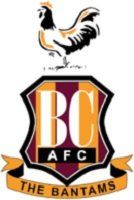Bradford

Bradford was and still rugby league country and it is with that game both its football - Bradford Park Avenue and Bradford City - began life. The former was founded in 1863 as Bradford FC but did not convert to the Association code until 1907. The latter first saw light Manningham FC in 1880 and had made the same switch of codes four years earlier.
Until that moment - May 1903 - the city of Bradford had had no Association football team of note. A Bradford City had existed in the local leagues from 1901 but it disbanded at the end of the 1902-3 season, by when another, more permanent ball had already been rolling for several months. And we know who it was who set that ball in motion. It seems unlikely to have been a player since he was a month off his fortieth birthday, although he might well have been for a reason that will become clear. He worked as a sub-editor on the local paper and had been a newspaper man since his teens. And his name was James Whyte cum White, James Tweedie Whyte and therein lies the clue to his origins. He was a Scot, a Lanarkshire-man, indeed his parents, his father a joiner and his mother a milner, hailed from Lanark itself. He, however, had been born in 1863 in Cambusnethan by Wishaw and had gown up in Airdrie. In 1881 at the height of the first Golden Era of the Scottish game he was living at 82, Chapel St. and was already working as an Apprentice Newspaper Clerk.
And it was a some point in the next decade he went south. Whilst not recorded anywhere in 1891 the following year he married Pudsey-born Emily Fieldsend at Holy Trinity Church already in Bradford. And it seems it was in the Yorkshire town that he remained, in1911 living at Sawrey Place, a house that is still there, before his death in 1921 but in Lancashire in Morecombe. That he did not die a very rich man might indicate that he had little or no financial stake in what had in his adopted home-town become a very successful football club. In 1920-21 it had finished 15th, so mid-table, in the English First Division. He had on the club's appointment in June 1903 of its first football-manager taken on the Secretarial role. He might even have had a role in the selection of that manager. He was Robert Campbell, Renton-born, half-brother of Renton and Sunderland forward, John Campbell. Robert Campbell had been a successful Secretary-Manager on Wearside and Bristol City and would go on to Clapton. At Bradford he would be immediately bring in seven Scots, increasing that number to ten the following season, one of whom was Jimmy Conlin, before in 1905 being replaced by Peter O'Rourke. Born at Newmains, once more just by Wishaw and immediately to the east of Cambusnethan, O'Rourke had been brought by Campbell to Yorkshire originally from Celtic as his centre-half, his Scottish centre-half. And O'Rourke was to remain with the club until 1921, increasing the Scots contingent to a maximum of fifteen in 1914-15, having won the Second Division in 1908 and in 1911 the FA Cup with his captain Govan's Jimmy Speirs, ex. Rangers and that day one of eight Scots in the team.
So how was James Whyte instrumental in Bradford City's creation. In January 1903 he had met at Valley Parade, then the home of Manningham, with John Blunt of the FA with the idea of creating a Football League in the city. Three months later it was agreed by the club. Three months later still the transformation was complete. Newly-named Bradford City had entered the League's second flight, displacing Doncaster Rovers and before it even had a team. It's first game was and away-defeat to Grimsby Town and in its first season of the first-teamers in its 20-man squad the bulk drawn from Tyne- and Wear-sides. and meaning as it was to go on, from Scotland. Certainly from its foundation set in motion by the football passion of yet another ex-patriate Scots until the Great War, in which Jimmy Spiers himself would lose his life at Passchendaele, it would be the beacon of the Scottish game in a county where otherwise the English game lingered both in Sheffield and Leeds.
